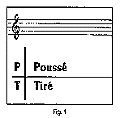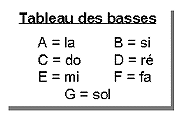The Universal System or CADB combines standard musical notation (solfa) with tablature. The tablature tells the accordionist which button to push and whether to push or pull the bellows. The standard musical notation indicates the note to be played.

The main weakness of tablature is that it is, of course, designed for a unique instrument, here a specific type of accordion. We will indicate which buttons the interpreter uses and in which direction he (she) operates the bellows, essential characteristic of the diatonic accordion.
This essential indication is put forward in our system of tablatures :"P" tells you to "pousser" (push/close) the bellows, "T" to "tirer" (pull/open) (fig. 1).
The numbers underneath indicate the button(s) to push. These are numbered downwards from the top (from bass to treble). The first row reads as: 1,2,3,etc. The second row is indicated by 1', 2', 3', etc. The third row: 1", 2", 3", etc. For reasons of clarity, a single horizontal line separates the "pull" from the "push". Above the line, you push; below the line, you pull ("tirer").

For the left hand accompaniment (bass), the note itself is written for more precision (only one letter)(fig. 2). This allows a guitarist or other musician to play along. The other (uniquely French "rows") system of tablature is also converted to this method of bass notation.
A capital letter means "bass" and a lower case letter means "chord". You'll see strings like this : A a a E e e (A bass, a chord, a chord, E bass, e chord, e chord)
On a 8 basses continental DBA (diatonic button accordion) all the chords are major except from the A chord that is minor.
The rhythm is written in two complimentary ways: first by the interval separating each note from its neighbor (extremely difficult to make on a computer), and second by standard musical notation (note values).
 Accordions of different pitches may play the music as written (ie; you may use A-D instead of G-C, etc.).
Accordions of different pitches may play the music as written (ie; you may use A-D instead of G-C, etc.).
In conclusion, the Universal System, also known as CADB system, has stood the test of time (first book in 1930!) and is accepted worldwide. It is indeed simple, very efficient, intuitive, and clear. One listing found it used in over 100 publications !
Melodeon (diatonic accordion) makers and reed makers all use this system !
Help for the translation : Philip Jamison and Mary Turner, USA